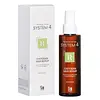What's inside
What's inside
 Benefits
Benefits

 Concerns
Concerns

 Ingredients Side-by-side
Ingredients Side-by-side

Water
Skin ConditioningPEG/PPG-18/18 Dimethicone
EmulsifyingCetrimonium Chloride
AntimicrobialPolyquaternium-28
Hydrolyzed Vegetable Protein Pg-Propyl Silanetriol
Skin ConditioningChitosan
Hydrolyzed Vegetable Protein
Skin ConditioningButylene Glycol
HumectantHelianthus Annuus Seed Extract
Skin ConditioningRosmarinus Officinalis Leaf Extract
AntimicrobialPropylene Glycol
HumectantPhenoxyethanol
PreservativeEthylhexylglycerin
Skin ConditioningPotassium Sorbate
PreservativeDisodium EDTA
Citric Acid
BufferingCaprylyl Glycol
EmollientLactic Acid
BufferingSorbitol
HumectantWater, PEG/PPG-18/18 Dimethicone, Cetrimonium Chloride, Polyquaternium-28, Hydrolyzed Vegetable Protein Pg-Propyl Silanetriol, Chitosan, Hydrolyzed Vegetable Protein, Butylene Glycol, Helianthus Annuus Seed Extract, Rosmarinus Officinalis Leaf Extract, Propylene Glycol, Phenoxyethanol, Ethylhexylglycerin, Potassium Sorbate, Disodium EDTA, Citric Acid, Caprylyl Glycol, Lactic Acid, Sorbitol
Water
Skin ConditioningCetearyl Alcohol
EmollientArgania Spinosa Kernel Oil
EmollientCocos Nucifera Oil
MaskingVitis Vinifera Seed Oil
EmollientC13-15 Alkane
SolventRicinus Communis Seed Oil
MaskingButylene Glycol
HumectantChitosan
Jojoba Esters
EmollientPolyglyceryl-6 Distearate
EmulsifyingGlyceryl Stearate
EmollientHydroxyethylcellulose
Emulsion StabilisingHydrogenated Castor Oil
EmollientPEG-100 Stearate
Caprylyl Glycol
EmollientDimethicone
EmollientC12-14 Sec-Pareth-5
EmulsifyingC12-14 Sec-Pareth-9
EmulsifyingPolyquaternium-37
Lactic Acid
BufferingBehentrimonium Chloride
PreservativeAcrylates Copolymer
Cetyl Alcohol
EmollientPolyglyceryl-3 Beeswax
EmulsifyingParfum
MaskingTetrasodium EDTA
Decylene Glycol
Skin ConditioningSodium Hydroxide
BufferingIsopropyl Alcohol
SolventDisodium EDTA
Benzoic Acid
MaskingDehydroacetic Acid
PreservativePhenoxyethanol
PreservativeCitral
PerfumingCitronellol
PerfumingLimonene
PerfumingWater, Cetearyl Alcohol, Argania Spinosa Kernel Oil, Cocos Nucifera Oil, Vitis Vinifera Seed Oil, C13-15 Alkane, Ricinus Communis Seed Oil, Butylene Glycol, Chitosan, Jojoba Esters, Polyglyceryl-6 Distearate, Glyceryl Stearate, Hydroxyethylcellulose, Hydrogenated Castor Oil, PEG-100 Stearate, Caprylyl Glycol, Dimethicone, C12-14 Sec-Pareth-5, C12-14 Sec-Pareth-9, Polyquaternium-37, Lactic Acid, Behentrimonium Chloride, Acrylates Copolymer, Cetyl Alcohol, Polyglyceryl-3 Beeswax, Parfum, Tetrasodium EDTA, Decylene Glycol, Sodium Hydroxide, Isopropyl Alcohol, Disodium EDTA, Benzoic Acid, Dehydroacetic Acid, Phenoxyethanol, Citral, Citronellol, Limonene
Ingredients Explained
These ingredients are found in both products.
Ingredients higher up in an ingredient list are typically present in a larger amount.
Butylene Glycol (or BG) is used within cosmetic products for a few different reasons:
Overall, Butylene Glycol is a safe and well-rounded ingredient that works well with other ingredients.
Though this ingredient works well with most skin types, some people with sensitive skin may experience a reaction such as allergic rashes, closed comedones, or itchiness.
Learn more about Butylene GlycolCaprylyl Glycol is a humectant and emollient, meaning it attracts and preserves moisture.
It is a common ingredient in many products, especially those designed to hydrate skin. The primary benefits are retaining moisture, skin softening, and promoting a healthy skin barrier.
Though Caprylyl Glycol is an alcohol derived from fatty acids, it is not the kind that can dry out skin.
This ingredient is also used as a preservative to extend the life of products. It has slight antimicrobial properties.
Learn more about Caprylyl GlycolWe don't have a description for Chitosan yet.
Disodium EDTA plays a role in making products more stable by aiding other preservatives.
It is a chelating agent, meaning it neutralizes metal ions that may be found in a product.
Disodium EDTA is a salt of edetic acid and is found to be safe in cosmetic ingredients.
Learn more about Disodium EDTALactic Acid is another well-loved alpha hydroxy acid (AHA). It is gentler than glycolic acid but still highly effective.
Its main role is to exfoliate the surface of the skin by loosening the “glue” that holds dead skin cells together. Shedding those old cells leads to smoother, softer, and more even-toned skin.
Because lactic acid molecules are larger than glycolic acid, they don’t penetrate as deeply. This means they’re less likely to sting or irritate, making it a great choice for beginners or those with sensitive skin.
Like glycolic acid, it can:
Lactic acid also acts as a humectant (like hyaluronic acid). It can draw water into the skin to improve hydration and also plays a role in the skin's natural moisturizing factor (NMF) in the form of sodium lactate.
Studies show it can boost ceramide production to strengthen the skin barrier and even help balance the skin’s microbiome.
To get results, choose products with a pH between 3-4.
Lower strengths (5-12%) focus on surface exfoliation; higher strengths (12% and up) can reach deeper in the dermis (deeper, supportive layer) to improve skin texture and firmness over time.
Though it was originally derived from milk, most modern lactic acid used in skincare is vegan. It is made through non-dairy fermentation to create a bio-identical and stable form suitable for all formulations.
When lactic acid shows up near the end of an ingredient list, it usually means the brand added just a tiny amount to adjust the product’s pH.
Legend has it that Cleopatra used to bathe in sour milk to help reduce wrinkles.
Lactic acid is truly a gentle multitasker: it exfoliates, hydrates, strengthens, and brightens. It's a great ingredient for giving your skin a smooth, glowing, and healthy look without the harshness of stronger acids.
Read more about some other popular AHA's here:
Learn more about Lactic AcidPhenoxyethanol is a preservative that has germicide, antimicrobial, and aromatic properties. Studies show that phenoxyethanol can prevent microbial growth. By itself, it has a scent that is similar to that of a rose.
It's often used in formulations along with Caprylyl Glycol to preserve the shelf life of products.
Water. It's the most common cosmetic ingredient of all. You'll usually see it at the top of ingredient lists, meaning that it makes up the largest part of the product.
So why is it so popular? Water most often acts as a solvent - this means that it helps dissolve other ingredients into the formulation.
You'll also recognize water as that liquid we all need to stay alive. If you see this, drink a glass of water. Stay hydrated!
Learn more about Water